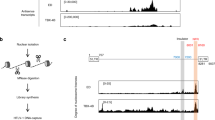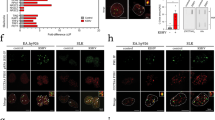Abstract
Emerging evidence suggests that supernumerary centrosomes drive genome instability and oncogenesis1,2,3. Human T-cell leukaemia virus type I (HTLV-I) is etiologically associated with adult T-cell leukaemia (ATL)4. ATL cells are aneuploid, but the causes of aneuploidy are incompletely understood5,6. Here, we show that centrosome amplification is frequent in HTLV-I-transformed cells and that this phenotype is caused by the viral Tax oncoprotein. We also show that the fraction of Tax protein that localizes to centrosomes interacts with TAX1BP2, a novel centrosomal protein composed almost entirely of coiled-coil domains. Overexpression of TAX1BP2 inhibited centrosome duplication, whereas depletion of TAX1BP2 by RNAi resulted in centrosome hyperamplification. Our findings suggest that the HTLV-I Tax oncoprotein targets TAX1BP2 causing genomic instability and aneuploidy.
This is a preview of subscription content, access via your institution
Access options
Subscribe to this journal
Receive 12 print issues and online access
$209.00 per year
only $17.42 per issue
Buy this article
- Purchase on Springer Link
- Instant access to full article PDF
Prices may be subject to local taxes which are calculated during checkout





Similar content being viewed by others
Accession codes
References
D'Assoro, A. B., Lingle, W. L. & Salisbury, J. L. Centrosome amplification and the development of cancer. Oncogene 21, 6146–6153 (2002).
Pihan G. A. et al. Centrosome defects and genetic instability in malignant tumors. Cancer Res. 58, 3974–3985 (1998).
Kramer, A. Centrosome aberrations — hen or egg in cancer initiation and progression? Leukemia 19, 1142–1144 (2005).
Gallo, R. C. The discovery of the first human retrovirus: HTLV-1 and HTLV-2. Retrovirology 2, 17 (2005).
Jeang, K.-T., Giam, C.-z., Majone, F. & Aboud, M. Life, death, and Tax: role of HTLV-I oncoprotein in genetic instability and cellular transformation. J. Biol. Chem. 279, 31991–31994 (2004).
Matsuoka, M. & Jeang, K.-T. Human T-cell leukemia virus type I at age 25: a progress report. Cancer Res. 65, 4467–4470 (2005).
Doxsey, S., McCollum, D. & Theurkauf, W. Centrosomes in cellular regulation. Annu. Rev. Cell Dev. Biol. 21, 411–434 (2005).
Gatza, M. L., Eatt, J. C & Marriott, S. J. Cellular transformation by the HTLV-I Tax protein, a jack-of-all-trades. Oncogene 22, 5141–5149 (2003).
Ching, Y.-P. et al. Specific TATAA and bZIP requirements suggest that HTLV-I Tax has transcriptional activity subsequent to the assembly of an initiation complex. Retrovirology 1, 18 (2004).
Jin, D.-Y., Spencer, F. & Jeang, K.-T. Human T-cell leukemia virus type I oncoprotein Tax targets the human mitotic checkpoint protein MAD1. Cell 93, 81–91 (1998).
Haoudi, A., Daniels, R. C., Wong, E., Kupfer, G. & Semmes, O. J. Human T-cell leukemia virus-I tax oncoprotein functionally targets a subnuclear complex involved in cellular DNA damage-response. J. Biol. Chem. 278, 37736–37744 (2003).
Duensing, S. & Munger, K. Human papillomaviruses and centrosome duplication errors: modeling the origins of genomic instability. Oncogene 21, 6241–6248 (2002).
Forgues, M. et al. Involvement of Crm1 in hepatitis B virus X protein-induced aberrant centriole replication and abnormal mitotic spindles. Mol. Cell. Biol. 23, 5282–5292 (2003).
Zou, C. et al. Centrobin: a novel daughter centriole-associated protein that is required for centriole duplication. J. Cell Biol. 171, 437–445 (2005).
Meraldi, P., Lukas, J., Fry, A. M., Bartek, J. & Nigg, E. A. Centrosome duplication in mammalian somatic cells requires E2F and Cdk2-cyclin A. Nature Cell Biol. 1, 88–93 (1999).
Lacey, K. R., Jackson, P. K. & Stearns, T. Cyclin-dependent kinase control of centrosome duplication. Proc. Natl Acad. Sci. USA 96, 2817–2822 (1999).
Matsumoto, Y., Hayashi, K. & Nishida, E. Cyclin-dependent kinase 2 (Cdk2) is required for centrosome duplication in mammalian cells. Curr. Biol. 9, 429–432 (1999).
Peloponese, J. M. Jr., Haller, K., Miyazato, A. & Jeang, K. T. Abnormal centrosome amplification in cells through the targeting of Ran-binding protein-1 by the human T cell leukemia virus type-1 Tax oncoprotein. Proc. Natl Acad. Sci. USA 102, 18974–18979 (2005).
Chun, A. C. S. et al. Coiled-coil motif as a structural basis for the interaction of HTLV-I Tax with cellular cofactors. AIDS Res. Hum. Retrov. 16, 1689–1694 (2000).
Jin, D.-Y. et al. A human suppressor of c-Jun N-terminal kinase 1 activation by tumor necrosis factor α. J. Biol. Chem. 272, 25816–25823 (1997).
Fry, A. M. et al. C-Nap1, a novel centrosomal coiled-coil protein and candidate substrate of the cell cycle-regulated protein kinase Nek2. J. Cell Biol. 141, 1563–1574 (1998).
Yang, J. et al. Rootletin, a novel coiled-coil protein, is a structural component of the ciliary rootlet. J. Cell Biol. 159, 431–440 (2002).
Yang, J. et al. The ciliary rootlet maintains long-term stability of sensory cilia. Mol. Cell. Biol. 25, 4129–4137 (2005).
Semmes, O. J. et al. HTLV-I and HTLV-II Tax: differences in induction of micronuclei in cells and transcriptional activation of viral LTRs. Virology 217, 373–379 (1996).
Gromley, A. et al. A novel human protein of the maternal centriole is required for the final stages of cytokinesis and entry into S phase. J. Cell Biol. 161, 535–545 (2003).
Ou, Y. Y., Mack, G. J., Zhang, M. & Rattner, J. B. CEP110 and ninein are located in a specific domain of the centrosome associated with centrosome maturation. J. Cell Sci. 115, 1825–1835 (2002).
Okuda, M. et al. Nucleophosmin/B23 is a target of CDK2/cyclin E in centrosome duplication. Cell 103, 127–140 (2000).
Bahe, S., Stierhof, Y.-D., Wilkinson, C. J., Leiss, F. & Nigg, E. A. Rootletin forms centriole-associated filaments and functions in centrosome cohesion. J. Cell Biol. 171, 27–33 (2005).
Wong, C. & Stearns, T. Centrosome number is controlled by a centrosome-intrinsic block to reduplication. Nature Cell Biol. 5, 539–544 (2003).
Nigg, E. A. Centrosome aberrations: cause or consequence of cancer progression? Nature Rev. Cancer. 2, 815–825 (2002).
Khodjakov, A. & Rieder, C. L. The sudden recruitment of γ-tubulin to the centrosome at the onset of mitosis and its dynamic exchange throughout the cell cycle, do not require microtubules. J. Cell Biol. 146, 585–596 (1999).
Chin, K.-T. et al. The liver-enriched transcription factor CREB-H is a growth suppressor protein underexpressed in hepatocellular carcinoma. Nucl. Acids Res. 33, 1859–1873 (2005).
Ching, Y. P., Pang, A. S., Lam, W. H., Qi, R. Z. & Wang, J. H. Identification of a neuronal Cdk5 activator-binding protein as Cdk5 inhibitor. J. Biol. Chem. 277, 15237–15240 (2003).
Paddison, P. J., Caudy, A. A. & Hannon, G. J. Stable suppression of gene expression by RNAi in mammalian cells. Proc. Natl Acad. Sci. USA 99, 1443–1448 (2002).
Jin, D. Y. et al. Hepatitis C virus core protein-induced loss of LZIP function correlates with cellular transformation. EMBO J. 19, 729–740 (2000).
Ching, Y. P. et al. Deleted in liver cancer (DLC) 2 encodes a RhoGAP protein with growth suppressor function and is underexpressed in hepatocellular carcinoma. J. Biol. Chem. 278, 10824–10830 (2003).
Acknowledgements
We thank K.-T. Chin, A.C.S. Chun and Y.T. Siu for critical reading of the manuscript. This work was supported by a grant to D.-Y.J. (HKU 7249/01M) from the Hong Kong Research Grants Council. D.-Y.J. is a Leukemia and Lymphoma Society Scholar and a recipient of a National Institutes of Health GRIP New Foreign Investigator Award (R01 TW06186-01) and National Natural Science Foundation of China Young Investigator Award (30029001). Work in the laboratory of K.-T.J. was supported through intramural funds from the National Institute of Allergy and Infectious Diseases of the National Institutes of Health.
Author information
Authors and Affiliations
Contributions
D.-Y.J. and K.-T.J. wrote the manuscript. Y.-P.C. and D.-Y.J., assisted by S.-F.C., designed, performed and analysed all experiments. K.-T.J. provided reagents and guidance in project planning. D.-Y.J. was responsible for the conceptualization and execution of the study.
Corresponding author
Ethics declarations
Competing interests
The authors declare no competing financial interests.
Supplementary information
Supplementary Information
Supplementary Figures S1, S2, S3, S4 and S5 (PDF 1055 kb)
Rights and permissions
About this article
Cite this article
Ching, YP., Chan, SF., Jeang, KT. et al. The retroviral oncoprotein Tax targets the coiled-coil centrosomal protein TAX1BP2 to induce centrosome overduplication. Nat Cell Biol 8, 717–724 (2006). https://doi.org/10.1038/ncb1432
Received:
Accepted:
Published:
Issue Date:
DOI: https://doi.org/10.1038/ncb1432
This article is cited by
-
Human T-cell lymphotropic virus HBZ and tax mRNA expression are associated with specific clinicopathological features in adult T-cell leukemia/lymphoma
Modern Pathology (2021)
-
Comparative analysis of the activation of unfolded protein response by spike proteins of severe acute respiratory syndrome coronavirus and human coronavirus HKU1
Cell & Bioscience (2014)
-
The tumor suppressor, TAX1BP2, is a novel substrate of ATM kinase
Oncogene (2014)
-
Suppression of innate antiviral response by severe acute respiratory syndrome coronavirus M protein is mediated through the first transmembrane domain
Cellular & Molecular Immunology (2014)



